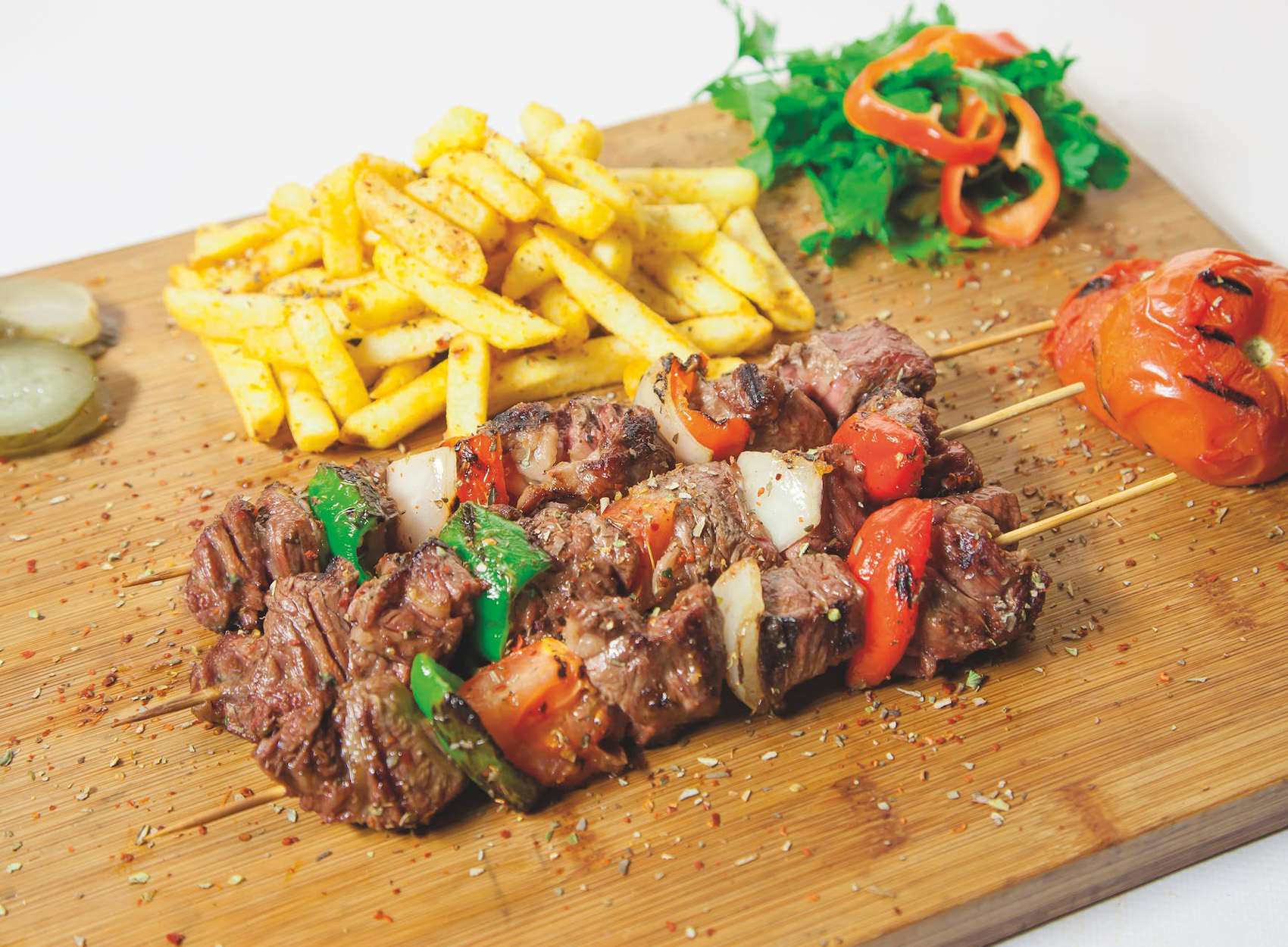How To Cut Steak Like A Pro
Steak should be sliced against the grain because it makes the meat easier to chew. The grain of a steak are actually it’s muscle fibers which all run in the same direction. If you look closely at a steak you’ll see a bunch of lines close together that run parallel to each other. These are the steak’s muscle fibers or grain. It’s harder to find the grain in tender cuts like tenderloin but much easier with tough cuts like flank. Once you find the grain, position the steak on a cutting board so its fibers run left to right. Then slice downward and toward your body which is against the grain. Its best to cut through steak in as few strokes as possible so use as sharp a knife as you can.
When cutting up your next T-bone, Ribeye or Porterhouse steak dinner, find the grain and rotate the plate or meat until the fibers are running left to right. Then slice downward against the grain to make each bite as tender as possible.
Don’t confuse the grain of a steak with its grill marks. They have nothing to do with one another and this is a common mistake people make when slicing beef. It makes no difference if you slice with or against the grill marks. The meat will be just as tender either way.
Always rest your steak for about 10 to 15 minutes after cooking and before cutting. Resting a steak consolidates and redistributes juices throughout the meat. It also allows the meat to cook about 5° F as it sits. This creates a more juicy, flavorful and tender steak.
Why Cut Steak Against The Grain
Once you’ve found the grain, slice against it in the opposite direction the grain is running. Do this by positioning the steak on a cutting board so that the grain runs left to right. Then cut in an up and down direction. Cutting with a steak knife should be done down and towards your body. As long as you position the steak correctly on the cutting board you’ll automatically be cutting against the grain.
Cutting against the grain shortens the meat’s muscle fibers. Shorter fibers are much easier to break down and chew which results in a more tender steak.
If you sliced parallel to, or with, the grain, each piece of meat would contain long, fibrous muscle fibers which are harder to chew. The result it a tough and chewy steak.
Properly cutting steak against the grain can make tough meat like flank or skirt tender enough for tacos, sandwiches or fajitas. And it can improve the tenderness of already tender steaks like tenderloin, top sirloin or ribeye.
Slicing meat against the grain can improve the tenderness of steak dishes that are sliced by a chef or when you cut your own steak dinner.
When cutting up your next T-bone or Top Sirloin steak dinner, find the grain and spin the plate or meat until the fibers are running left to right. Then slice downward against the grain making each bite as tender as possible.
How Do You Know Which Way The Grain Runs In Steak?
The grain of a steak refers to its muscle fibers. If you examine either a cooked or raw steak, you can see all it individual fibers running throughout the meat. They’re easy to spot because they generally all run in the same direction. The fibers on a tender cuts of steak like tenderloin will be harder to see because they’re much less pronounced. However tough steak cuts like flank or skirt are easy to find because the fibers are very pronounced. As a general rule, the tougher the meat the easier the grain is to find.
Once you successfully cut a steak against the grain, you’ll be able see the severed ends of its muscle fibers.
You can still see a steak’s muscle fibers after you cook it. However, it can be more difficult because of the grill marks, seasonings and sauces you put on it. In this case, make a cut and examine the inside to see what the fibers look like.
It’s just as important to slice raw beef against the grain as cooked beef. There are many recipes that call for thinly sliced raw beef. In these cases, always cut against the grain to make the meat more tender.
Let The Meat Rest Before Cutting
Never cut a steak right after you cook it. Let it rest for a few minutes instead. Smaller cuts need about 10 minutes rest but large steaks can sit for 15. Cover the meat in foil and let it sit by itself away from the heat. Resting allows its juices to consolidate and redistribute evenly throughout the steak. This creates a more evenly cooked and juicy steak. If you slice a steak right away without resting it first, its juices won’t be sealed in and will run as soon as you cut.
Resting steak also lets the heat it absorbed while cooking continue to cook the meat for a short time. This allows you to remove the steak from heat sooner than you otherwise would.
A steak will cook another 5° F on average while it rests. Keep this in mind when grilling because you could overcook a steak while it rests.
How To Properly Rest Steak
Just before your steak reaches the desired internal temperature, remove it from the fire and place it on a cutting board. Loosely cover it with some aluminum foil but don’t wrap it tight. This creates space for airflow which allows your steak to release heat as it continues to cook inside. On average, beef will cook another 5° F as it rests. Smaller cuts need about 10 minutes rest but large steaks can sit for 15.
You can also rest steak without covering it with aluminum foil. Its juices will still redistribute throughout the meat but it won’t cook as much inside. This is a better method if you plan on using a little steak butter on your meat.
When you check a steak with a meat thermometer, stab it into the top of the meat. This keep juices trapped inside the meat. If you stab into the bottom or side juices could run out of the hole.
Remove the aluminum foil, slice and serve your steak.
Always Cut With A Sharp Knife
Always cut steak with the sharpest knife you have. A sharp knife cuts cleaner through the meat and doesn’t tear it up or make the meat jagged. Cutting steak should be done in a downward motion towards your body at first and then forward and back again. If the knife is sharp it slices through the meat cleanly which leaves a sharp edge.
A sharp knife should be able to cut through a 2 inch thick steak in a stroke or two. If you have to make a bunch of cuts to get through your knife probably needs sharpening.
Thick knives are better than thin when cutting through beef. They give you better leverage and control over the cut.
Should You Cut Cubed Steak Against The Grain?
Yes, cubed steak should be cut against the grain to make it as tender as possible. First, lay your steak on a cutting board with the grain running up and down. Then slice the meat with the grain in 1 or 2 inch wide rows. Next, rotate the steak so that the strips are facing left to right. Slice them in a downward motion towards your body in 1 or 2 inch thick rows. This both cubes the meat and cuts against the grain.
Do You Cut Steak With Or Against The Grain?
You should always slice steak against the grain, which means against the direction that the muscle fibers run. This is true no matter what cut of beef your slicing, raw or cooked. Cutting beef against the grain make it easier to break down and chew. While cutting meat with the grain makes it tough and chewy.
What Does it Mean To Cut Steak Against The Grain?
Cutting against the grain means to cut the fibers in the opposite direction they’re running. This shortens the fibers making them more tender and easier to chew. The grain of a steak refers to its muscle fibers. Every muscle is made up of strings of fibers which run perpendicular to each other in a single direction. To cut a steak against the grain, place it on a cutting board with the grain running left to right. Then slice down and toward your body.
Summary: How To Cut Steak Like A Pro
Steak should be sliced against the grain because it makes the meat easier to chew. The grain of a steak are actually it’s muscle fibers which all run in the same direction. If you look closely at a steak you’ll see a bunch of lines close together that run parallel to each other. These are the steak’s muscle fibers or grain. It’s harder to find the grain in tender cuts like tenderloin but much easier with tough cuts like flank. Once you find the grain, position the steak on a cutting board so its fibers run left to right. Then slice downward and toward your body which is against the grain. Its best to cut through steak in as few strokes as possible so use as sharp a knife as you can.
When cutting up your next T-bone, Ribeye or Porterhouse steak dinner, find the grain and rotate the plate or meat until the fibers are running left to right. Then slice downward against the grain to make each bite as tender as possible.
Don’t confuse the grain of a steak with its grill marks. They have nothing to do with one another and this is a common mistake people make when slicing beef. It makes no difference if you slice with or against the grill marks. The meat will be just as tender either way.
Always rest your steak for about 10 to 15 minutes after cooking and before cutting. Resting a steak consolidates and redistributes juices throughout the meat. It also allows the meat to cook about 5° F as it sits. This creates a more juicy, flavorful and tender steak.
If you have any questions about how to properly cut steak like a chef, email any time.
























